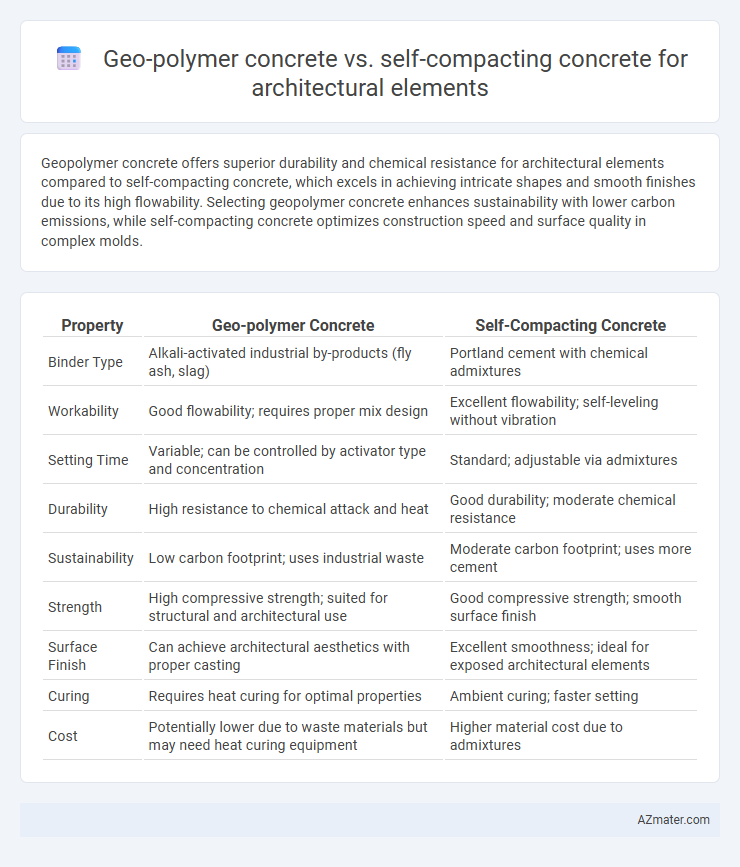Geopolymer concrete offers superior durability and chemical resistance for architectural elements compared to self-compacting concrete, which excels in achieving intricate shapes and smooth finishes due to its high flowability. Selecting geopolymer concrete enhances sustainability with lower carbon emissions, while self-compacting concrete optimizes construction speed and surface quality in complex molds.
Table of Comparison
| Property | Geo-polymer Concrete | Self-Compacting Concrete |
|---|---|---|
| Binder Type | Alkali-activated industrial by-products (fly ash, slag) | Portland cement with chemical admixtures |
| Workability | Good flowability; requires proper mix design | Excellent flowability; self-leveling without vibration |
| Setting Time | Variable; can be controlled by activator type and concentration | Standard; adjustable via admixtures |
| Durability | High resistance to chemical attack and heat | Good durability; moderate chemical resistance |
| Sustainability | Low carbon footprint; uses industrial waste | Moderate carbon footprint; uses more cement |
| Strength | High compressive strength; suited for structural and architectural use | Good compressive strength; smooth surface finish |
| Surface Finish | Can achieve architectural aesthetics with proper casting | Excellent smoothness; ideal for exposed architectural elements |
| Curing | Requires heat curing for optimal properties | Ambient curing; faster setting |
| Cost | Potentially lower due to waste materials but may need heat curing equipment | Higher material cost due to admixtures |
Introduction to Geo-Polymer and Self-Compacting Concrete
Geo-polymer concrete is an eco-friendly alternative to traditional cement concrete, utilizing industrial by-products like fly ash or slag activated by alkaline solutions to form a durable binder with reduced carbon footprint. Self-compacting concrete (SCC) is designed for high fluidity and flowability, enabling it to fill complex formworks without mechanical vibration, ensuring smooth surfaces and intricate architectural details. Both materials enhance architectural elements by offering distinct advantages: geo-polymer concrete prioritizes sustainability and chemical resistance, while SCC emphasizes workability and finish quality.
Key Material Properties Comparison
Geo-polymer concrete offers high chemical resistance and reduced carbon footprint while maintaining comparable compressive strength to traditional concretes. Self-compacting concrete excels in flowability and segregation resistance, enabling intricate architectural shapes without mechanical vibration. Both materials provide superior durability; however, geo-polymer concrete demonstrates enhanced fire resistance and lower permeability, making it ideal for exposed architectural elements.
Environmental Impact Assessment
Geopolymer concrete offers significantly lower carbon emissions compared to self-compacting concrete due to its reduced reliance on Portland cement, making it a greener choice for architectural elements. Self-compacting concrete, while providing superior flowability and surface finish, often involves higher embodied energy associated with traditional cement production. Environmental impact assessments highlight geopolymer concrete's potential for sustainability by utilizing industrial by-products like fly ash, thereby reducing waste and ecological footprint in construction.
Workability and Placement Techniques
Geo-polymer concrete offers enhanced workability due to its thixotropic nature, allowing for easy shaping and reduced segregation, which is beneficial for complex architectural elements. Self-compacting concrete achieves superior flowability and fills intricate formworks without vibration, ensuring high surface finish quality on architectural surfaces. Placement techniques for geo-polymer concrete often involve careful control of mix temperature and curing conditions, while self-compacting concrete requires attention to mix design parameters like viscosity modifiers to maintain stability during casting.
Structural Performance in Architectural Elements
Geo-polymer concrete exhibits superior durability and chemical resistance compared to traditional Self-compacting concrete, making it ideal for architectural elements exposed to harsh environments. Its enhanced mechanical strength and reduced shrinkage improve the structural performance of complex shapes and intricate detailing. Self-compacting concrete offers excellent flowability and ease of placement in intricate molds, but may exhibit lower long-term durability and higher permeability than geo-polymer alternatives.
Durability and Longevity Factors
Geo-polymer concrete exhibits superior durability and longevity for architectural elements due to its high chemical resistance, low permeability, and enhanced fire resistance compared to traditional concrete types. Self-compacting concrete offers excellent workability and uniform surface finish but may have slightly reduced long-term durability, especially in aggressive environmental conditions. Selection between the two depends on specific exposure risks and the desired lifespan, with geo-polymer concrete often preferred for projects demanding exceptional durability and sustainability.
Aesthetic Flexibility and Surface Finish
Geo-polymer concrete offers superior aesthetic flexibility for architectural elements due to its customizable color palettes and ability to incorporate diverse aggregate types, resulting in unique textures and finishes. Self-compacting concrete provides a smooth, uniform surface finish with excellent flowability, minimizing surface defects and enhancing detailed formwork replication. Both materials enable high-quality architectural finishes, but geo-polymer concrete allows for greater creative freedom in color and texture variations.
Cost Analysis and Economic Considerations
Geo-polymer concrete offers significant cost savings in architectural elements due to its lower raw material costs and reduced energy consumption during production compared to traditional Portland cement used in self-compacting concrete. Self-compacting concrete provides enhanced labor efficiency and faster construction times, potentially offsetting its higher material costs with reduced overall project expenses. Economic considerations must weigh the balance between initial material investment and long-term sustainability benefits, where geo-polymer concrete excels in minimizing environmental impact and lifecycle costs.
Case Studies in Architectural Applications
Geo-polymer concrete offers enhanced thermal resistance and environmental sustainability in architectural elements, as demonstrated in the University of Queensland's Innovation Centre where it improved durability and reduced carbon footprint. Self-compacting concrete facilitates complex formworks and intricate designs, evidenced by its use in the Yas Hotel Abu Dhabi, achieving high surface quality and seamless finishes without vibration. Case studies reveal geo-polymer concrete excels in eco-friendly, resilient structures, while self-compacting concrete optimizes aesthetic detail and construction efficiency in architectural applications.
Future Trends and Innovations in Concrete Technology
Geo-polymer concrete offers sustainable advantages with low carbon emissions and enhanced resistance to chemicals, making it ideal for innovative architectural elements demanding durability and eco-friendliness. Self-compacting concrete excels in complex formworks and intricate designs due to its high fluidity and superior surface finish, advancing automation in construction processes. Future trends emphasize hybrid formulations combining geo-polymer binders with self-compacting properties to optimize mechanical performance, sustainability, and aesthetic flexibility in modern architectural applications.

Infographic: Geo-polymer concrete vs Self-compacting concrete for Architectural element
 azmater.com
azmater.com